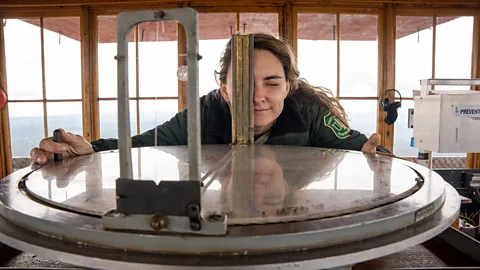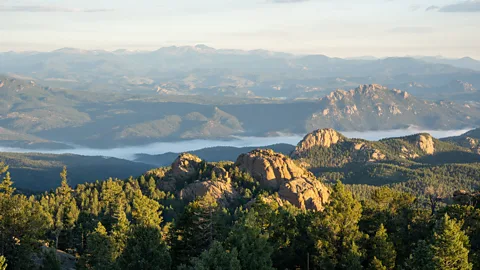The guardian of Colorado's Front Range
 Kate Schoenbach
Kate SchoenbachIn addition to guarding the forest against wildfires, Ashley Farinacci-Silfies is responsible for maintaining the fire tower – one of the last remaining in the United States.
At the summit of Devil's Head, the highest point in the state of Colorado's Rampart Range in Pike National Forest, Ashley Farinacci-Silfies stood in her lookout tower, gripping a pair of binoculars: "That could be a fire," she said, looking intently into the distance. Shortly afterwards, she realised it was only dust, likely from a dirt bike, mimicking the smoky wisp of a new fire. "Luckily, not this time."
Named for its jagged peak, Devil's Head soars 9,748ft into the sky in the Rampart Range, part of Colorado's Front Range that makes up the easternmost edge of the Rocky Mountains. The mountain offers stunning vistas that extend east towards Kansas, west to the Continental Divide, north to Wyoming and south to Pike's Peak, a popular "fourteener" – mountaineering parlance meaning a mountain over 14,000ft. To preserve the forest's beauty, fire management is crucial.

50 Reasons to Love the World - 2021
Why do you love the world?
"Because of the kindness and resiliency of the communities affected by wildfire, as well as the resiliency and regrowth of the burned landscape." – Ashley Farinacci-Silfies, fire lookout
Employed by the US Forest Service, Farinacci-Silfies is the last remaining fire lookout in Colorado's Front Range, and the Devil's Head Lookout tower is one of only a handful of fire towers in the US that still maintain seasonal operations. Her job, which she has been doing for two seasons, has largely been replaced by technology, such as 360-degree cameras, drones and aircraft equipped with heat sensors used to detect new fire starts. But, according to Farinacci-Silfies, "Technology can't replace me." She points out that forest service teams appreciate the flexibility offered only by humans; our ability to synthesise information and respond to teams on the ground is something that "drones can't do".
Farinacci-Silfies's job as a fire lookout requires her to spend six months of the year living in a remote log cabin accessible only on foot via the Devil's Head trail, a 1.25-mile hike covering 900ft of elevation. However, much of her time is spent in the nearby fire lookout tower, perched atop the terminus of the Devil's Head trail, one of the Denver area's most popular.
Farinacci-Silfies appreciates the novelty of her work, marvelling at the beauty of her surroundings. "Every hour the sun changes, illuminating something different that I haven't seen before."
Comprised of a diverse mix of flora and fauna, Pike National Forest is a prime example the wild splendour found in America's west. Ponderosa pine, Douglas fir and aspen trees mix with wild strawberries and Columbine flowers (Colorado's state flower) to create an ambiance of enchanted beauty. Farinacci-Silfies explains that although sightings are rare, visitors should be mindful of the mountain lions and bears that call the forest home. "We coexist here," she said.
Pike National Forest and the surrounding area offer a multitude of trails with breath-taking views. Visitors enjoy a variety of activities, including hiking, camping, fishing, mountain biking and horseback riding. Covering an area of more than one million acres, the forest offers something for everyone, and its proximity to Denver makes it accessible.
Every day during fire season, generally running from May to November, Farinacci-Silfies climbs the 143 steps to her lookout tower to watch for signs of smoke, usually arising from campfires or lightning strikes. Once she detects smoke, she determines the fire's location using her Osborne firefinder, a measurement tool used to find the azimuth, or directional bearing, of the distant fire, developed in 1911 by US Forest Service employee William Osborne. She then radios down to dispatch, who send firefighting crews to respond. Last year, Ashley spotted five fires, though hundreds more burned throughout the state.
The Front Range is prone to wildfires due to its dry climate. 2020 was the worst wildfire year on record, as nearly 700,000 acres burned. "Last year on the northern Front Range we saw a lot of wildfire activity, but it wasn't as far south as us here in the Rampart Range area" Farinacci-Silfies said. "Lately this area has been largely untouched." Though she hasn't yet spotted any uncontrolled wildfires this season due to an unusually wet summer, she expects wildfire season to pick up as the rain subsides.
 Kate Schoenbach
Kate SchoenbachFarinacci-Silfies's job is multidimensional. In addition to guarding the forest against wildfires, she is responsible for maintaining the fire tower, one of the best known in the United States due to its stunning views and unique history.
Shortly after the US Forest Service was established in the early 20th Century, a series of seven major fire lookout towers were planned along the Front Range, from Wyoming to New Mexico, to aid in the detection of wildfires. Devil's Head was one of the original sites. First stationed in 1912, a lookout tower was built in 1919 and was staffed by Helen Dowe, the first female fire lookout in Colorado and the second in the United States, after Hallie Morse Dagger of California. In 1951, the Army's Company A, 973rd Engineer Construction Battalion from Fort Carson built the new tower, which is still in use today. Over the years, the tower gained local prominence due to its unique position atop a large granite outcrop, with panoramic views of the Front Range. In 1991, Devil's Head Lookout was placed on the National of Historic Places.
Farinacci-Silfies took over the lookout position two years prior from veteran lookout Billy Ellis, who retired at 87. During his 35 seasons staffing the Devil's Head lookout, Ellis spotted 200 fires and climbed the equivalent of Mt. Everest 43 times. Thinking back to the origins of the Forest Service, Farinacci-Silfies smiles at the fact that now, 100 years after Helen Dowe first staffed the tower, a woman is again watching over the forest.
 Kate Schoenbach
Kate SchoenbachWhen Farinacci-Silfies is not fire spotting, she es the time learning about the forest's various flora and fauna, understanding which cloud formations could mean lightning, talking with hikers and playing with her two cats, Fjord and Fiona.
Sitting at the desk in her lookout tower, she reflects on the devastating impact wildfires can have on the surrounding area. She notes that the 2002 Hayman fire, Colorado's largest wildfire until last year, saw 137,000 acres burn, or 30% of Farinacci-Silfies's "seen" area – forest service lingo indicating the area lookouts can see within 360 degrees from their towers. Although she was not working during the Hayman fire, Farinacci-Silfies learned about its devastation during her forest management studies at Kent State University. "It was one of the worst wildfires in Colorado state history," she said.
Over the years, forest fires in the western United States have intensified due to people encroaching upon arid areas and allowing forests to grow unabated, creating deep underbrush that serves as a tinderbox. Farinacci-Silfies points out that changes in climate have exacerbated the issue, as fires burn longer than they ever have before. Last year more than 10 million acres burned throughout the United States, setting a record for total acres burned since accurate recording began.
 Kate Schoenbach
Kate SchoenbachDespite her job's risks, Farinacci-Silfies feels called to preserve the forest, having forged a deep connection to the wilderness as a child camping with her mother. Farinacci-Silfies wants others to experience the joys of hiking and camping for "generations to come", and sees her guardianship over the forest as a way to protect the environment for those around her.
When asked what she loves most about living in the forest, Farinacci-Silfies said, "Just waking up when the sun rises and going to bed when the sun sets – and getting to watch the way everything changes when the sun moves across the mountains. I'm most grateful for that constant, rhythmic flow."
BBC Travel celebrates 50 Reasons to Love the World in 2021, through the inspiration of well-known voices as well as unsung heroes in local communities around the globe.
---
more than three million BBC Travel fans by liking us on Facebook, or follow us on Twitter and Instagram.
If you liked this story, sign up for the weekly bbc.com features newsletter called "The Essential List". A handpicked selection of stories from BBC Future, Culture, Worklife and Travel, delivered to your inbox every Friday.
{"image":{"pid":""}}
